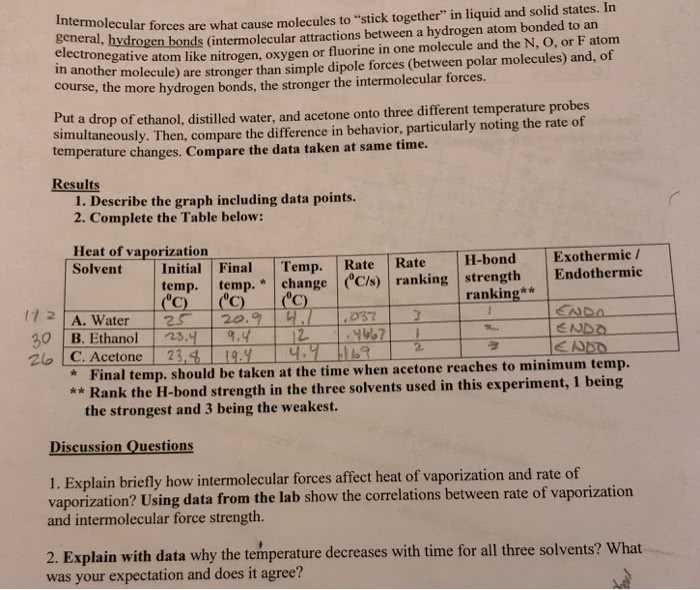Chemistry 162 Lab Activity
Introduction Water has an amazing ability to adhere (stick) toitself and to other substances. Hydrogen bonds form when hydrogenatoms covalently bonded to nitrogen (N), oxygen (O), or fluorine(F) in the form of covalent compounds such as ammonia (NH3), water(H2O) and hydrogen fluoride gas (HF). In these molecules, thehydrogen atoms do not pull as strongly on the shared electrons asthe N, O, or F atoms. Therefore, the molecules are polar; thehydrogen atoms become positively charged and are able to formhydrogen bonds to negative ions or negatively charged parts ofother molecules (such as the N, O, and F atoms that becomenegatively charged in these compounds). Hydrogen bonds are not truebonds like covalent bonds or ionic bonds. Hydrogen bonds areattractions of electrostatic force caused by the difference incharge between slightly positive hydrogen ions and other, slightlynegative ions. These attractions are much weaker than true ionic orcovalent bonds, but they are strong enough to result in someinteresting properties.
In the case of water, hydrogen bonds form between neighboringhydrogen and oxygen atoms of adjacent water molecules. Theattraction between individual water molecules creates a bond knownas a hydrogen bond (Fig. 1).
Fig. 1: Hydrogen bonds shown as the dotted lines between watermolecules.
Cohesion Molecules of pure substances are attracted to themselves.This sticking together of like substances is called cohesion.Depending on how attracted molecules of the same substance are toone another, the substance will be more or less cohesive. Hydrogenbonds cause water to be exceptionally attracted to each other.Therefore, water is very cohesive.
Adhesion Adhesion is similar to cohesion, but it involves unlike(i.e. different) substances sticking together. Water is veryadhesive; it sticks well to a variety of different substances.Water sticks to other things for the same reason it sticks toitself â because it is polar so it is attracted to substances thathave charges. In this lab activity, you will be asked to use thematerials and procedures provided to explore the properties ofwater that involve both cohesion and adhesion. Be sure to writedown your observations and results as you progress. sults as youprogress.
Fig. 1
:
Hydrogen bonds shown as the dotted
lines between water molecules.
Part 1:
Exploring Water
Procedure
A.
How many drops of water can you fit on the surface of a pennywithout the water spilling over?
1.
Predict how many drops of water will fit on a penny. Record yourprediction.
2.
Use the plastic pipette to drop water on the surface of a penny.Drop car
efully and slowly to fit as
many drops as possible on the penny. Count each drop until thewater spills over the side of the
penny and record your results.
3.
Compare your results to those of your classmates. Record therange and calculate the average
number
of drops that fit on a penny.
4.
Add more drops to the penny, without letting the water spillover. Carefully observe and draw the
water on the penny.
5.
Record
a hypothesis for the behavior of water that you observed, usingthe language of cohesion
and adhesion
in relation to the water and the penny.
A.
Record your results and
thinking in your notebook.
B.
Can you
disturb
the water on the penny without spilling it?
1.
A
dd drops of water to the penny, until the water is almost readyto spill over.
2.
Predict what will
happen when you insert a toothpick into the surface of the waterpiled on the
penny. Record your prediction.
3.
Insert the
toothpick
and carefully observe the surface of the water.
4.
Try inserting the
toothpick
in various ways. Observe the surface of the water.
Pay special attention to
the water surface where the skewer enters the water.
5.
Record your observations and draw what you see.
6.
Repeat
these
procedures using a paper clip and the metal clip part of abinder clip. Try to indent the
pile of water as much as p
ossible without spilling it.
7.
Record your observations and dra
w what you see, paying careful
attention to the surface of the
water.
8.
Record
a hypothesis for the behavior of water that you observed usingthe language of cohesion
and adhesion in relation to the
toothpick
, the paperclip, the binder clip, and the water.
B.
Record your results and
thinking in your notebook.would you please answer the questionfor me . Thanks



